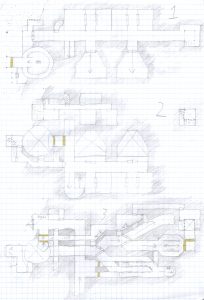I’ve always been a fan of non-linearity in game design.
Some time ago, I read Justin Alexander’s series on Jacquaying, and immediately decided I wanted to use those principles — loops, elevation changes, and meaningful choice — in the maps I designed.
Using the tools wrong
Recently, I got to run my first full-size dungeon (built, of course, on my understanding of these principles).
It didn’t quite work.
Early on, the PCs began a five-session running battle up and down the corridors. While there were a couple of flanking manoeuvres (mostly by enemies who knew the dungeon), the vertical structure of the building barely got a look-in. The lever system that could fill rooms with smoke was completely irrelevant.
By the end, they’d defeated most of the guards, and the main boss, but hadn’t seen more than a quarter of the keyed rooms.
Making a better layout
That adventure left me a lot to reflect on, but for this post I want to focus on the dungeon layout.
I was recently linked (in the comments of this post by Simon_C) to an article by Steve Gaynor about level design in F.E.A.R, which gives a really concrete explanation of why you want circular paths in a dungeon.
The F.E.A.R. article highlighted two things I did wrong: establishing shots, and tactically useful loops.
Establishing Shots
The establishing shot is what you see when you walk into an encounter. In an RPG, this would be the GM’s description. “You open the door, and see two orcs fighting a bugbear. What do you do?”
We’ve all seen those big wide-angle shots in movies, and they certainly look cool; but why would you use them in a game? It’s hard to convey the awesomeness of a sweeping vista with a few spoken words.
Gaynor’s point is that the establishing shot also shows the players their tools. Is there a pit you can push people into? Is there a door where reinforcements could arrive, or PCs escape? Are there civilians or vegetation to blend in with? Drawing out a wide room full of obstacles gives players more choice than only showing the one chamber they’re in, even if the actual layout is much the same.
In my claustrophobic corridors, the party had no idea what was round the next corner, let alone hidden in side rooms. Of course those things didn’t come up!
Tactical Loops
These loops are the same ones Justin Alexander and Simon_C discuss: paths through the dungeon that take the PCs back where they started, from a new direction.
But Gaynor is talking about them in a tactical sense: you go down a side passage, and come out behind the enemies your allies are still fighting. This means players need to be able to find, and use, these loops in combat time.
While I put in a lot of loops, they were mostly too big to do this. (One outnumbered squad of guards tried to flank the PCs, but the guards who stayed were dead by the time their flankers arrived.)
In my next dungeon, I’m going to make the layout mean something.
I’m considering an open vertical centre to orient the PCs, and little clusters of connected rooms where fights can circle back and forth.
Isikyus

Since writing this, I’ve realised a much more obvious problem with my design: all the encounters are in the rooms, but the loops consist entirely of corridors. If the players had to go through the rooms to circle around an enemy, they wouldn’t have been able to put off facing the room encounters until they controlled the dungeon.